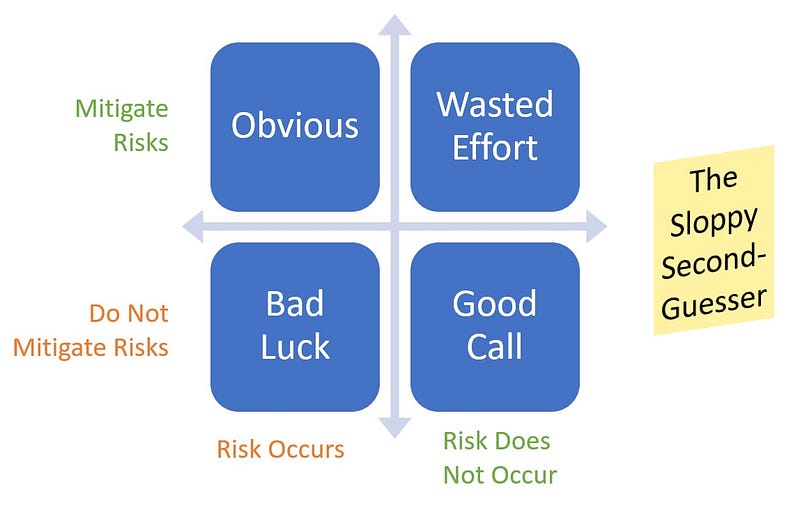How Not to Be a Sloppy Second Guesser

Greetings friends!
Join me on a simple thought experiment to understand how risk management works. You can then apply these principles to your own life to make better decisions.
The Umbrella Decision
Let’s imagine you’re heading out for a walk. How do you decide whether to take an umbrella with you? Under what circumstances would you second-guess your decision?
How you feel about your decision depends on two things: what you knew before you left the house, and what happened outside until your feet once again cross the threshold of your door.
If it’s a sunny day with a clear forecast, you have no trouble leaving the umbrella at home. The idea of taking it never crosses your mind.
Similarly, if it’s already pouring out your decision is easy. We call it a no-brainer because you don’t have to think.
Seen this way, it’s clear all the magic happens amidst uncertainty. It’s not raining now but it might rain later. You make a judgment call in the face of not knowing whether you’ll need the umbrella or not.

Amidst Uncertainty, We Emphasize the Downside
Let’s say you decide to take the umbrella. Then if it rains, you feel good about your decision. You decided correctly!
- And if it doesn’t rain, you are happy not to have needed your umbrella.
- You took reasonable action to mitigate a risk that didn’t occur. You feel OK about it even though it was, in one sense, a “wasted” effort.
Now let’s say you decide to take your chances and leave the umbrella at home. If it rains, you feel bad about your decision.
- To save yourself a small inconvenience (carrying the umbrella), your clothes were soggy all afternoon.
- But if it doesn’t rain, you don’t celebrate too much because you don’t take an umbrella every day it doesn’t rain.

When you mitigate risks, you are happy if they occur and fine if they don’t occur. Remember you didn’t know what would happen. It was a risk, not a certainty.
Second-Guessing Based on Outcomes Is Common … and Wrong
The whole point of risk management is making decisions when the outcome is uncertain.
Thus, we properly judge such decisions based on the conditions when they were made, not on the ultimate outcome.
After events have played out, it is worse than useless to say “Knowing what we know now, you should have done X, not Y.”
People do this all the time, however. Worse, they fall prey to hindsight bias and falsely remember what they thought and knew at the time.

Hindsight bias is widespread
You will hear people saying things like the following:
- “I could see the housing crisis forming. Anyone with half a brain knew the market was unsustainable.”
- “Well, it’s obvious that all that money printing and deficit spending was going to cause inflation.”
- “I knew the vaccine wouldn’t work. It was developed and rolled out in record time. It was a no-brainer not to put that unknown substance into my body.”
To the sloppy second-guesser, taking steps to mitigate risks that occur is no big deal because the risk was obvious (in hindsight). And it was a wasted effort to mitigate risks that did not occur.

Similarly, the sloppy second guesser thinks they made a good call when a risk they did nothing to mitigate does not occur and suffered from bad luck when it does.
It Is No Mistake To Plan for Risks That Do Not Occur
Just as it is no mistake to plan for risks that never happen, it is no victory to hope for the best and get lucky. At least not from a risk management perspective.
The proper way to think about risk management under conditions of uncertainty is as follows:

It is sensible to mitigate against risk amidst uncertainty regardless of whether the risk occurs or not.
As a corollary, you are a fool not to mitigate risks, also regardless of outcomes. You are unlucky if the risk does not occur, and lucky if it does, but a fool either way.
Don’t let what everyone knows after the fact turn you into a sloppy second guesser.
Be well.
Hit reply to tell me what's on your mind or write a comment directly on Klugne. If you received this mail from a friend and would like to subscribe to my free weekly newsletter, click here.
This article appeared originally on Medium in the publication Change Becomes You.






Member discussion